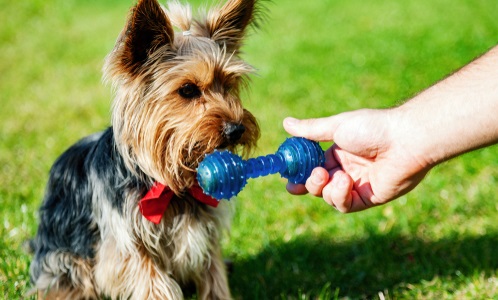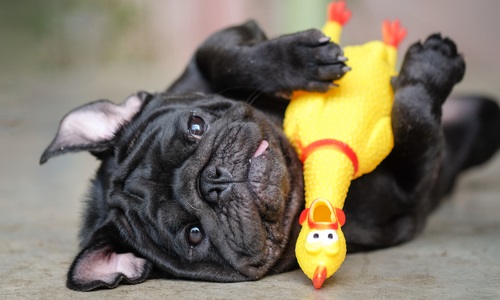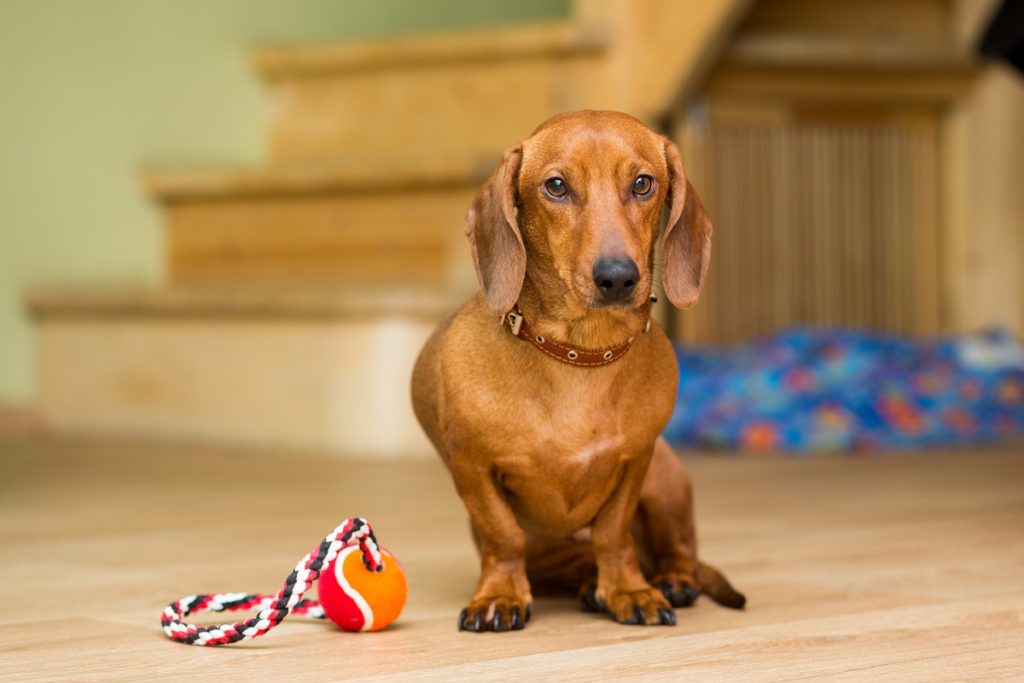The need for play is an integral part of your dog’s daily routine. Dogs use playtime to communicate, build trust, and engage in stimulating activity. For a dog, play is a demonstration of ability as well as a tool that will help him learn about his surrounding environment. Most dogs love to play, but play styles vary between breeds and are even more distinct with every specific dog depending on individual personality. Dogs engage in play in a multitude of ways, and sometimes, you may not even realize your dog is playing.
The most common form of play between humans and dogs involves toys, so it can be disconcerting when a dog stops playing with one, or all, of their toys. There are many reasons why a dog may be prone to losing interest in their toys. Boredom, stress, and desire for increased affection could all be contributing factors for a dog losing interest in toy-centric play. If you have ever thought to yourself, “My dog doesn’t like to play with toys, what do I do?” this article is here to help. This guide will be covering some of the most obvious reasons why your dog doesn’t want to play with toys and provide helpful tips on getting your furry companion to enjoy playtime.
Why Your Dog Won’t Play With Toys
Most commonly, dogs lose interest in their toys due to boredom. In the same way, you like to get new things, your dog also likes fun new changes. Even a toy that may have previously been your dog’s favorite is subject to become old news. It is good to keep several toys in rotation to keep your dog’s interest piqued. Typically if a dog begins to favor one toy over the rest, keep the toy that is being shown the most love out for your dog to play with. When introducing a new toy to combat boredom, it is best to remove all other toys from the rotation so your dog can understand that this new toy is a special treat.
 It is possible that too many toys can cause overstimulation, and as a result, your dog won’t choose any toys at all. A good practice is to keep toys visible but also out of reach. This tells the dog that the toy is something to be desired and is a privilege during playtime.
It is possible that too many toys can cause overstimulation, and as a result, your dog won’t choose any toys at all. A good practice is to keep toys visible but also out of reach. This tells the dog that the toy is something to be desired and is a privilege during playtime.
Having a scheduled time of day for play is another way to prevent boredom in your dog. If toys are always out and accessible, then there is nothing special about those moments when you try and engage your dog with a toy. Alternately, if your dog understands that at some point in the late afternoon, he’s going to get to play tug of war with you and his favorite rope toy, then the anticipation builds throughout the day and keeps your dog interested on that specific toy.
Don’t be shy about getting your dog hyped up! When beginning playtime, it is a good practice to treat the toy as if it is your favorite. Your dog will mirror the excitement you show about an object or a person, and if you get amped up about the toy, you have in your possession. Showing the dog the toy and then tossing it around is a great way to stimulate your dog’s brain. Remember to be vocal. As you pair rapid movement with increased vocal cues, your dog’s instincts will begin to kick in, and he will naturally become more excited as he notices the change to a hyper-stimulated environment.
Dog’s are by their nature creatures of habit and as a result, having a routine that you share with them is an integral part of daily life with a dog. Setting up a similar play time each day with a specific toy or two will help combat boredom by feeding into your dog’s desire for regimented routine.
When your dog loses interest in playing with toys, it could be a sign that he is experiencing higher stress levels or canine anxiety. Make sure your dog is getting plenty of exercises to combat any increased levels of stress. Remember that your dog plays in many different forms and that different kinds of stimulation are vital for maintaining a well-balanced lifestyle for your dog. If you usually play in the house with a stuffed animal, try moving outdoors and playing fetch with your dog. If your pup typically plays one on one with you, go to a dog park. This will help to socialize your dog with other canines. Yes, your dog craves structure and routine, but just like you, your dog likes to shake it up every once in a while.
 In the eyes of your dog, there is no one more important to them than you, their owner. Your dog craves your companionship, approval, and affection. Playing with your dog is one of the best ways to show your dog you love them. A dog acting out and not playing with toys could just be a sign that they want you to try a little harder. Don’t be afraid to switch up your methods for playtime while maintaining a routine that matches the activity level your dog needs.
In the eyes of your dog, there is no one more important to them than you, their owner. Your dog craves your companionship, approval, and affection. Playing with your dog is one of the best ways to show your dog you love them. A dog acting out and not playing with toys could just be a sign that they want you to try a little harder. Don’t be afraid to switch up your methods for playtime while maintaining a routine that matches the activity level your dog needs.
Sources:
“My Dog Doesn’t Like Toys.” Fun Paw Care, 10 Nov. 2014, www.funpawcare.com/2014/07/28/my-dog-doesnt-like-toys/
Bender, Amy. “How to Teach a Dog to Play.” The Spruce Pets, 27 Apr. 2019, www.thesprucepets.com/train-a-dog-to-play-1117214.
“How To Teach Your Dog To Play With Toys.” Jolly Pets, 8 Sept. 2014, www.jollypets.com/how-to-teach-your-dog-to-play-with-toys/




